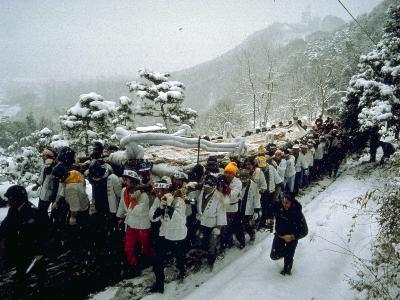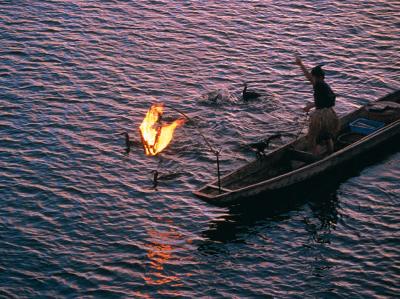|
The Shinobusanzan-akatsuki-mairi festival is held at Haguro Shrine, which is located on Mt Shinobusan. This mountain looms over the center of Fukushima City.
The festival is held every February on the 10th and 11th. This festival, widely known for its enshrinement of a 'giant waraji sandal' has continued for more than 300 years since the Edo period. The festival first originated when a giant waraji sandal was enshrined for the Nio-sama guardian statue enshrined inside the Nio Gate which used to stand in front of Haguro Shrine.
Currently, a giant waraji sandal is enshrined by the Onyama-keishinkai of the Onyama quarter as a prayer for plentiful harvests, family safety and personal health.
This giant sandal is 12m long, 1.4m wide and weighs 2 tons. 3,000 batches of straw, nearly 10,000 square meters of cloth, and 10 kilograms of rope are also used to make it. It takes seven people ten days to complete the sandal. Since the path to the shrine is covered with wet, slippery snow, it is said that participants of this festival tend to build up strong legs.
The festival is held every February on the 10th and 11th. This festival, widely known for its enshrinement of a 'giant waraji sandal' has continued for more than 300 years since the Edo period. The festival first originated when a giant waraji sandal was enshrined for the Nio-sama guardian statue enshrined inside the Nio Gate which used to stand in front of Haguro Shrine.
Currently, a giant waraji sandal is enshrined by the Onyama-keishinkai of the Onyama quarter as a prayer for plentiful harvests, family safety and personal health.
This giant sandal is 12m long, 1.4m wide and weighs 2 tons. 3,000 batches of straw, nearly 10,000 square meters of cloth, and 10 kilograms of rope are also used to make it. It takes seven people ten days to complete the sandal. Since the path to the shrine is covered with wet, slippery snow, it is said that participants of this festival tend to build up strong legs.
| [+ADDRESS] | 
|












